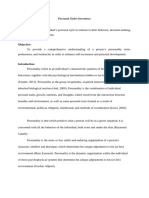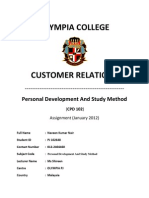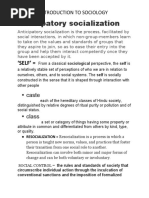Personality: I) Heredity: The Genetic Components Inherited From Our Parents at The Time of
Uploaded by
Rohan TandonPersonality: I) Heredity: The Genetic Components Inherited From Our Parents at The Time of
Uploaded by
Rohan TandonPERSONALITY
Introduction
People tend to have a general notion that personality refers to a personal appearance with
charming smile, or outlook. But psychologists view the concept as dynamic in nature concerned
with growth and development of a person’s whole psychological system.
Personality can be defined as the consistent psychological patterns within an individual that
affect the way they interact with others and the situations they encounter. Personality is defined
as relatively stable and enduring characteristics that determine our thoughts, feelings and
behavior. Personality is a complex phenomenon and there are various perspectives of personality
construct. One common and simple definition of Personality is: It is the consistent psychological
patterns within an individual that affect the way they interact with others and the situations they
encounter.
"Personality is the dynamic organization within the individual of those psychophysical systems
that determine his characteristics behaviour and thought" (Allport, 1961, p. 28).
“The characteristics or blend of characteristics that make a person unique” (Weinberg & Gould,
1999).
Personality Determinants
There are several factors that determine the formation or shaping of our personality. Among
them the three major factors are:
i) Heredity: The genetic components inherited from our parents at the time of
conception determine strongly the personality characteristics of an individual. The
color, height, physical statutory, facial attractiveness, gender, temperament, muscle
composition, inheritable diseases etc are considered to be inherited from our parents.
ii) Environment: The culture in which people are brought up in their lives and they type
of socialization process such as family’s child rearing practices, socio economic
status of the family, number of children in a family, birth order, education of the
parents, friends and peer group pressures, religious practices, the type of schooling
and recreational activities, pastime behavior etc play a critical role in shaping our
personalities.
i) Situation: The type of specific situation which a person encounters also equally
shapes the type of personality characteristics. For example, an individual’s exposure
to a job interview and the type of experiences encountered during that time will shape
certain personality characteristics. Similarly, going for a picnic with friends and
encountering the type of experiences whether pleasant and unpleasant will shape the
personality characteristics of individuals.
Prepared by: Dr. Priya, Assistant Professor, 1
IMS, University of Lucknow
Personality Traits
Popular characteristics including shy, aggressive, submissive, lazy, ambitious, loyal and
timid. Those characteristics, when they exhibited in large number of situations, are called
personality traits or enduring characteristics that describe on individual’s behavior.
Primary Traits
Cattel (1973) identified 16 source traits/Primary Traits. These traits were found to be generally steady and
constant sources of behaviour. But there was found to be no scientific relevance.
Sixteen Source Traits
1. Reserved - Outgoing
2. Less intelligent - More intelligent
3. Affected by feelings - Emotionally stable
4. Submissive - Dominant
5. Serious - Happy go Lucky
6. Expedient - Conscientious
7. Timid - Venturesome
8. Tough minded - Sensitive
9. Trusting - Suspicious
10. Practical - Imaginative
11. Forthright - Shrewd
12. Self-Assured - Apprehensive
13. Conservative - Experimenting
14. Group-dependent - Self-sufficient
15. Uncontrolled - Controlled
16. Relaxed - Tense
In the type approach, several behaviours are seen as cluster characterising individuals with high degree of
stability.
The Myers-Briggs Type Indicator (MBTI)
MBTI describes four dimensions of Personality Types:
(a) Extroversion versus Introversion: (The ways in which people relate to the world)
(b) Sensing versus Intuition: (Becoming aware of and perceiving information)
(c) Thinking versus feeling: (Ways of deciding and prefer to make judgments)
(d) Judging and Perception: (The amount of control exercising and organizing people)
a) Extroversion and Introversion: This deals with whether the focus of attention is directed
towards outwardly or inwardly. Where do you prefer to focus your attention?
Extroversion: Extroverted attention flows outward to the world of objects and people or external
ideas. They are interacting more with people. Characteristics associated with people who prefer
Extraversion are:
• Attuned to external environment
• Prefer to communicate by talking
Prepared by: Dr. Priya, Assistant Professor, 2
IMS, University of Lucknow
• Work out ideas by talking them through
• Have broad interests
• Sociable and expressive
• Readily take initiative in work and relationships
Extroverts are usually active, sociable, like variety and stimulation, and are often good speakers,
sales people or public relations professionals.
Introversion: Introverted attention focused on the subjective, inner world of thoughts, feelings
and ideas. Introverts like quit reflection, can concentrate on one idea or thought for longer than
an extrovert, and are less active and prone to change. Characteristics associated with people who
prefer Introversion are:
• Drawn to their inner world
• Prefer to communicate in writing
• Work out ideas by reflecting on them
• Learn best by reflection, mental “practice”
• Focus in depth on their interest
• Private and contained
Research scientists, academicians and librarians are often introverts.
b) Sensing Versus Intuition:
This aspect deals with the ways of collecting information and ideas.
Sensing: A person with a sensing preferences focuses on the specific, practical and tangible. The
sensing person relies more on the physical or material reality of the world of the five senses:
touch, sight, sound, taste or smell. Sensing managers take in information through their senses and
attend to the details of the problem. They like to solve problems in standard ways. They are
patient with routine details and are precise in their work. They distrust creative inspirations and
usually work all the way through to reach conclusions. They emphasize action, urgency and
bottom-line results. Characteristics associated with people who prefer Sensing:
• Oriented to present realities
• Factual and concrete, precise and practical
• Focus on what is real and actual
• Observe and remember specifics
• Build carefully and thoroughly toward conclusions
• Understand ideas and theories through practical applications
• Trust experience
The sensing person is likely to provide a practical solution to problems. They may be good at
repairing machines, sports, building, handicrafts, or keeping the detailed records of a business.
Intuition: This person relies more on their insights and based on that they guess, assume and
draw the inferences. Ideas, associations or creative process often accompany the presence of
Prepared by: Dr. Priya, Assistant Professor, 3
IMS, University of Lucknow
intuition. They focus on the relationships and connections between facts. Intuition manager like
solving new problems and are impatient with routine details. They perceive the problem in its
totality and consider several alternatives simultaneously. They are imaginative and futuristic,
enjoying mind testing games. Characteristics associated with people who prefer Intuition:
• Oriented to future possibilities
• Imaginative and verbally creative
• Focus on the patterns and meanings in data, sees beyond the surface
• Remember specifics when they relate to pattern
• Move quickly to conclusions, follow hunches
• Want to clarify ideas and theories before putting them into practice
• Trust inspiration
The intuitive person is likely to have an affinity for music, literature, the arts, higher
mathematics, and science and abstract theories. People with high level of intuition are also likely
to be creative, adaptable and open to new ideas, and they are often artists, musicians, strategic
players or architects.
c) Thinking versus Feeling:
These deals with the way people make decisions.
Thinking: The person with a preference for thinking tends to be objective, analytical and
impersonal in decision and judgments. Thinking managers are logical and analytical in their
problem solving and search for additional information in a logical manner. Characteristics
associated with people who prefer Thinking:
• Solve problem with logic,
• Use cause and effect reasoning
• Strive for an objective standard of truth
• Can be “tough-minded”
• Fair – want everyone treated equally
Feeling: People who use feelings to make decision are more likely to be empathetic, loyal, and
appreciative and tactful. Feeling types consider the person and are likely to bend the rules if the
situation warrants. Feeling managers heavily emphasize the human aspects in dealing with
organizational problems and is more process oriented. They enjoy pleasing people and avoid
conflicts.
Intuitive Feelers (NF) have personal charisma and commitments to the people they lead. They
communicate their caring and enthusiasm. They are comfortable in an unstructured, group-
centered management system that lets employees participate in the decision making process. If
adequate NF’s are not available in organization, an organization will become cold, sterile and
dull.
Possible Shortcomings; NF’s make decision on the basis of personal likes and dislikes.
They often try to please others all the time. Characteristics associated with people who prefer
Feeling:
• Empathetic
• Guided by personal values
• Assess impacts of decisions on people
Prepared by: Dr. Priya, Assistant Professor, 4
IMS, University of Lucknow
• Strived for harmony and positive interactions
• Compassionate
• May appear “tenderhearted”
They like helping other people and often work as nurses, counselors and artists. They use past
experiences and values and seek harmony when making judgments.
d) Judgment versus Perception
This aspect deals with the amount of control a person has over events and organizing things.
Judgment: The strong Judgment oriented people tend to live in a planned, decided and orderly
way, wanting to regulate their life and control events. They are given more responsibility and
authority because their operating mode is stable and predictable. Characteristics associated with
people who prefer Judging:
• Scheduled
• Organize their lives
• Systematic
• Methodical
• Make short and long term plans
• Like to have things decided
• Try to avoid last-minute stresses
The person with a strong orientation for judgment will therefore be good at making decision and
planning. They usually make good managers, engineers and lawyers.
Perception: Perceptive people tend to live in a flexible, spontaneous way, wanting to understand
life and adapt to it. They often appear to be more relaxed and less organized than judging types
and are less attracted to schedules and routines. Characteristics associated with people who
prefer Perceiving:
• Spontaneous
• Flexible
• Casual
• Open-ended
• Adapt, change course
• Like things loose and open to change
• Feel energized by last minute pressures.
The perceptive type, on the other hand, may wait until all the information and aspects of
situation are seen before they make a decision. Artists, consultants, musicians and counselors
tend to be perception oriented.
Big Personality Traits
There are five Big Personality Traits which have a significant impact in individual’s life.
They are as follows:
Prepared by: Dr. Priya, Assistant Professor, 5
IMS, University of Lucknow
a) Extroversion: Extroverts are sociable, lively, and gregarious and seek outward
interaction. Such individuals are likely to be most successful working in marketing
division, public relations etc. where they can interact face to face with others. Introverts
are quite, reflective, introspective and intellectual people, preferring to interact with a
small intimate circle of friends. Introverts are more likely to be successful when they can
work on highly abstract ideas (accountant, R&D work etc) in a relatively quite
atmosphere.
b) Agreeableness: This refers to the extent to which individuals agreeing and cooperating
with others. Highly agreeable people are cooperative, warm and trusting. People who
score low on agreeableness are cold, disagreeable and antagonistic. This characteristic is
very important and critical in attaining a successful achievement in their life.
c) Conscientiousness: This refers to the extent to which people are responsible and
dependable in their work and life. A highly conscientiousness person is responsible,
organized, dependable and persistent. They are likely to move upward direction very
quickly and attain remarkable achievement in their life. Those who score low on this
dimension are easily distracted, disorganized and unreliable.
d) Emotional Stability: This refers to the extent to which people have the ability to
withstand stress. People with positive emotional stability tend to be calm, self confident
and secure. Those with highly low level of emotional stability tend to be nervous,
anxious, depressed and insecure.
e) Openness to experience: This refers to the extent to which people are more imaginative,
artistic sensitivity and intellectualism. Individuals tend to vary widely ranging from
conservative to creative or artistic. Extremely open people are creative, and artistically
sensitive. Whereas not so open category personnel are very conservative and find comfort
in the familiar or routine activities.
Major Personality Attributes Influencing OB
Locus of control: People are assumed to be of two types: `Internals' and `Externals'. Internals are people
who believe that much of what happens to them is controlled by their destiny. Externals believe that much
of what happens to them is controlled by outside forces.
Machiavellianism: High Machs tend to take control, especially in loosely structured situations; Low
Machs respond well to structured situations. High Machs tend to be more logical, rational and Pragmatic.
They are more skilled in influencing and coalition building.
Self-esteem
People differ in the degree to which they like or dislike themselves. This trait is called self-esteem.
Individuals with high self-esteem will take more risks in job selection and more likely to choose
unconventional jobs than people with low self-esteem.
Self-monitoring
A personality trait that measures on individuals ability to adjust his or her behavior to external, situational
factors. Individuals high in self-monitoring show considerable adaptability in adjusting their behavior to
external situational factors. They are highly sensitive to external cues and can behave different situations.
Prepared by: Dr. Priya, Assistant Professor, 6
IMS, University of Lucknow
Risk Taking
This refers to the extent to which people are willing to take chances. This propensity to assume
or to avoid risk has been shown to have an effect on their decision making capabilities and
information gathering process. High risk taking managers made more rapid decision and used
less information in making their choices than did the low risk taking managers.
Type ‘A’ or Type ‘B’
People who are Hard-driving, impatient, aggressive, and super competitive are termed as Type `A'
Personality. Those who are easy-going, sociable, laid-back and non-competitive are termed as Type `B'
Personality. Type A people tend to be very productive and work very hard. They are workaholics. The
negative side of them is that they are impatient, not good team players, more irritable, have poor
judgment. Type B people do better on complex tasks involving judgment, accuracy rather than speed and
team work.
Suggestive Readings:
• Organizational Behaviour, by Stephen P. Robbins
• Understanding Human Behavior by Udai Pareek
Prepared by: Dr. Priya, Assistant Professor, 7
IMS, University of Lucknow
You might also like
- Confidential Investigation Report: IssueNo ratings yetConfidential Investigation Report: Issue24 pages
- Riki Anne Wilchins - Read My Lips - Sexual Subversion and The End of Gender-Firebrand Books (1997) PDFNo ratings yetRiki Anne Wilchins - Read My Lips - Sexual Subversion and The End of Gender-Firebrand Books (1997) PDF116 pages
- Understanding Self and Others Through MbtiNo ratings yetUnderstanding Self and Others Through Mbti59 pages
- Personality: Sagar Gaonkar Prashant DesaiNo ratings yetPersonality: Sagar Gaonkar Prashant Desai21 pages
- Module 4 PERSONALITY ATTITUDES AND BEHAVIORNo ratings yetModule 4 PERSONALITY ATTITUDES AND BEHAVIOR7 pages
- MODULE 3 - Human Behavior in Organizations100% (1)MODULE 3 - Human Behavior in Organizations51 pages
- University School of Business Bachelor of Business Adminstration100% (1)University School of Business Bachelor of Business Adminstration31 pages
- Lecture Personality and Interest Inventories 8No ratings yetLecture Personality and Interest Inventories 841 pages
- Personality: Is Like All Other People Is Like Some Other People Is Like No Other PeopleNo ratings yetPersonality: Is Like All Other People Is Like Some Other People Is Like No Other People13 pages
- Personality Development Assignment Completed50% (10)Personality Development Assignment Completed22 pages
- The Beginner's Guide To MBTI and Typing YourselfNo ratings yetThe Beginner's Guide To MBTI and Typing Yourself4 pages
- Ia-2 Report of Organizational BehaviourNo ratings yetIa-2 Report of Organizational Behaviour18 pages
- Abv Indian Institute of Information Technology and ManagementNo ratings yetAbv Indian Institute of Information Technology and Management17 pages
- Module 3 Personality, Ability, Attitude and ValuesNo ratings yetModule 3 Personality, Ability, Attitude and Values51 pages
- Personality Types, A Simple Guide To The Condition, Diagnosis, Treatment And Related ConditionsFrom EverandPersonality Types, A Simple Guide To The Condition, Diagnosis, Treatment And Related ConditionsNo ratings yet
- Mastering Thought Power: The Science and Practice of Positive ThinkingFrom EverandMastering Thought Power: The Science and Practice of Positive ThinkingNo ratings yet
- Shipping Label 123828437 1091129587031 PDFNo ratings yetShipping Label 123828437 1091129587031 PDF1 page
- We Don'T See Things As They Are, We See Things As We Are.No ratings yetWe Don'T See Things As They Are, We See Things As We Are.13 pages
- 2013the Antecedents of Consumer Satisfaction and Loyalty in Fast Food IndustryNo ratings yet2013the Antecedents of Consumer Satisfaction and Loyalty in Fast Food Industry21 pages
- Understanding Individual Motivation: Michael Angelo Mendez, MpsychNo ratings yetUnderstanding Individual Motivation: Michael Angelo Mendez, Mpsych31 pages
- Cancer Pain Management: Syafruddin Gaus, MD, PHD, Span-KmnNo ratings yetCancer Pain Management: Syafruddin Gaus, MD, PHD, Span-Kmn72 pages
- Lesso N Plan School Subject Teacher Marie Ann Sol P. Quarter Date Grade I ObjectivesNo ratings yetLesso N Plan School Subject Teacher Marie Ann Sol P. Quarter Date Grade I Objectives4 pages
- 2017 Chu ITTFProceedings AcceptedPaperVersionNo ratings yet2017 Chu ITTFProceedings AcceptedPaperVersion9 pages
- WORK IMMERSION AT EMA EMITS College Philippines A Technical Report Is Presented atNo ratings yetWORK IMMERSION AT EMA EMITS College Philippines A Technical Report Is Presented at25 pages
- Opening: Facilitator's Manual Facilitator's ManualNo ratings yetOpening: Facilitator's Manual Facilitator's Manual15 pages
- Writting Skill_7e2c8d5f-3fba-4b64-9b60-738f63dfb1b5No ratings yetWritting Skill_7e2c8d5f-3fba-4b64-9b60-738f63dfb1b553 pages
- Group 4: Chheang Sarakpanha Chhun Venyory Lim Sengtong Prak Bolin Sambo UtdomNo ratings yetGroup 4: Chheang Sarakpanha Chhun Venyory Lim Sengtong Prak Bolin Sambo Utdom10 pages
- Superheroes and Developmental PsychologyNo ratings yetSuperheroes and Developmental Psychology3 pages
- Saint Gregory Academy: Indang, Cavite S.Y. 2017 - 2018100% (1)Saint Gregory Academy: Indang, Cavite S.Y. 2017 - 20182 pages
- Unlocked! - The Secrets of Analyzing People on the FlyFrom EverandUnlocked! - The Secrets of Analyzing People on the Fly
- Riki Anne Wilchins - Read My Lips - Sexual Subversion and The End of Gender-Firebrand Books (1997) PDFRiki Anne Wilchins - Read My Lips - Sexual Subversion and The End of Gender-Firebrand Books (1997) PDF
- University School of Business Bachelor of Business AdminstrationUniversity School of Business Bachelor of Business Adminstration
- Personality: Is Like All Other People Is Like Some Other People Is Like No Other PeoplePersonality: Is Like All Other People Is Like Some Other People Is Like No Other People
- Abv Indian Institute of Information Technology and ManagementAbv Indian Institute of Information Technology and Management
- Module 3 Personality, Ability, Attitude and ValuesModule 3 Personality, Ability, Attitude and Values
- Personality Types, A Simple Guide To The Condition, Diagnosis, Treatment And Related ConditionsFrom EverandPersonality Types, A Simple Guide To The Condition, Diagnosis, Treatment And Related Conditions
- Mastering Thought Power: The Science and Practice of Positive ThinkingFrom EverandMastering Thought Power: The Science and Practice of Positive Thinking
- We Don'T See Things As They Are, We See Things As We Are.We Don'T See Things As They Are, We See Things As We Are.
- 2013the Antecedents of Consumer Satisfaction and Loyalty in Fast Food Industry2013the Antecedents of Consumer Satisfaction and Loyalty in Fast Food Industry
- Understanding Individual Motivation: Michael Angelo Mendez, MpsychUnderstanding Individual Motivation: Michael Angelo Mendez, Mpsych
- Cancer Pain Management: Syafruddin Gaus, MD, PHD, Span-KmnCancer Pain Management: Syafruddin Gaus, MD, PHD, Span-Kmn
- Lesso N Plan School Subject Teacher Marie Ann Sol P. Quarter Date Grade I ObjectivesLesso N Plan School Subject Teacher Marie Ann Sol P. Quarter Date Grade I Objectives
- WORK IMMERSION AT EMA EMITS College Philippines A Technical Report Is Presented atWORK IMMERSION AT EMA EMITS College Philippines A Technical Report Is Presented at
- Opening: Facilitator's Manual Facilitator's ManualOpening: Facilitator's Manual Facilitator's Manual
- Writting Skill_7e2c8d5f-3fba-4b64-9b60-738f63dfb1b5Writting Skill_7e2c8d5f-3fba-4b64-9b60-738f63dfb1b5
- Group 4: Chheang Sarakpanha Chhun Venyory Lim Sengtong Prak Bolin Sambo UtdomGroup 4: Chheang Sarakpanha Chhun Venyory Lim Sengtong Prak Bolin Sambo Utdom
- Saint Gregory Academy: Indang, Cavite S.Y. 2017 - 2018Saint Gregory Academy: Indang, Cavite S.Y. 2017 - 2018






























































































